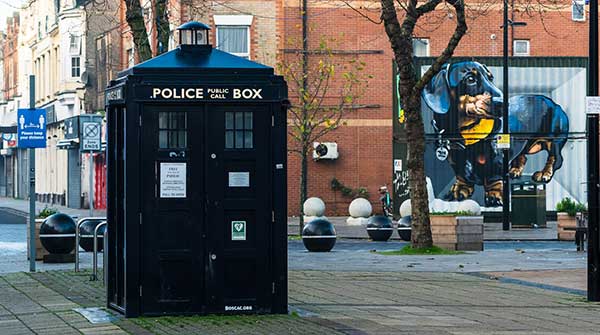Unravelling the enigma of Doctor Who and its massive following in the UK and beyond
 During Christmas and New Year’s, I enjoyed the festivities and caught up on several things. In particular, I watched some recent episodes of the long-running BBC series Doctor Who, including the regeneration process from the 14th to the 15th Doctor, on Disney+.
During Christmas and New Year’s, I enjoyed the festivities and caught up on several things. In particular, I watched some recent episodes of the long-running BBC series Doctor Who, including the regeneration process from the 14th to the 15th Doctor, on Disney+.
Doctor Who is an enigma to those who haven’t watched it in North America. While they may know the name and possibly a few scenes and catchphrases, they don’t completely understand its success and massive following in the UK and around the world, including Canada. They’re also unaware of its massive empire containing books, magazines, clothing, movies, DVD and Blu-ray sets, art prints – and more.
A little bit of background is probably in order.
 The Tardis |
| Related Stories |
| When Mister Rogers met Mr. Dressup
|
| Murdoch Mysteries – then and now
|
| Netflix’s ‘Ancient Apocalypse’ is more fiction than fact
|
Doctor Who has been a popular staple on British TV since 1963. It’s a science fiction series featuring a titular character, the Doctor. This extraterrestrial life form is a Time Lord who travels the universe on a spaceship called the TARDIS (“Time And Relative Dimension In Space”), which resembles a police box. The Doctor is joined by a companion on his adventures – most of them platonic but with some romantic deviations. He’s fought many creatures, robots and villains, including regular adversaries like the Cybermen, Zygons, Ice Warriors and, of course, the Daleks.
William Hartnell played the first Doctor from 1963 to 1966. Sadly, some episodes remain lost due to the old practice of erasing master tapes of shows rather than preserving them. He was replaced by Patrick Troughton, who held the role until 1969. This was accomplished with the first televised use of the regeneration process, which changes the Doctor’s physical appearance and personality traits.
The first Doctor Who episode I watched featured Troughton’s replacement, Jon Pertwee. His run occurred between 1970 and 1974, but was still on regular rotation on TVO, which used to carry the BBC series in Canada. His work was always top-flight, as was that of his replacement, Tom Baker, the longest-serving Doctor from 1974 to 1981.
Pertwee and Baker are probably the two most distinctive-looking Doctors. The former is widely known for his shocking white hair and proper British mannerisms. The latter’s jovial personality and trademark long scarf are instantly recognizable.
Three more Doctors followed: Peter Davison, Colin Baker and Sylvester McCoy. The first series was cancelled in 1989 due to diminishing ratings. Many fans were disappointed, although the BBC often suggested the show could return. A one-episode attempt in 1996 to build an international series around a new Doctor, Paul McGann, had solid viewing numbers on BBC but not on its U.S.-based co-producer, Fox.
At long last, Doctor Who returned on BBC in 2005 with Christopher Eccleston in the lead role. He only stayed one season but had such a positive impact that it breathed new life into the program. Eccleston was followed by a line of talented personalities – David Tennant, Matt Smith, Peter Capaldi, Jodie Whittaker (first female Doctor), Tennant (first person to hold the role twice) and Ncuti Gatwa (first black Doctor).
The regeneration between Tennant and Gatwa occurred during the Dec. 9, 2023 special, “The Giggle.” It was a superb episode that guest-starred American actor Neil Patrick Harris as the Toymaker, a villain last seen in the 1966 serial The Celestial Toymaker, which is mostly missing save for the last episode. It also focuses on Stooky Bill (the ventriloquist dummy’s head that Scottish inventor John Logie Baird famously transmitted in 1924 on a mechanical television), UNIT headquarters (the fictional military organization that studies extraterrestrial and paranormal threats) and the appearance of two Doctors at once.
It’s the latter point that briefly made this episode the talk of the town.
Tennant and Gatwa went through a “bi-generation,” which enabled the Time Lord to split into two separate and co-existing entities. After they defeated the Toymaker, Gatwa’s Doctor used the villain’s remaining power to create a second TARDIS. Tennant’s Doctor retired and joined the family of his companion, Donna Noble (Catherine Tate), on Earth. The new incarnation charted his course for mystery, suspense and adventure.
While there have been specific stories with several older Doctors appearing at once, they always disappeared. That’s not the case here – and, it seems, going forward. Longtime showrunner Russell T Davies said during a recent Doctor Who podcast, “the creation of the Doctorverse in the moment of that bigeneration – it’s much bigger than you think and I hope could lead to all sorts of things ….I think all of the Doctors came back to life with their individual TARDISes, the gift of the Toymaker, and they’re all out there travelling round in what I’m calling a Doctorverse.”
This should lead to some interesting storylines – and a fair bit of confusion.
Gatwa’s first regular episode, “The Church on Ruby Road,” was broadcast on Christmas Day. It introduced his new companion, Ruby Sunday (Millie Gibson), as they fought goblins, saved a baby and engaged in time travel. His version of the Doctor is fun, upbeat and whimsical. It’ll be interesting to see how Gatwa ultimately does. He’s certainly off to a good start.
Will the mystery of Doctor Who finally disappear in North America in 2024? Who knows, and in more ways than one.
Michael Taube, a Troy Media syndicated columnist and Washington Times contributor, was a speechwriter for former Prime Minister Stephen Harper. He holds a master’s degree in comparative politics from the London School of Economics.
For interview requests, click here.
The opinions expressed by our columnists and contributors are theirs alone and do not inherently or expressly reflect the views of our publication.
© Troy Media
Troy Media is an editorial content provider to media outlets and its own hosted community news outlets across Canada.

